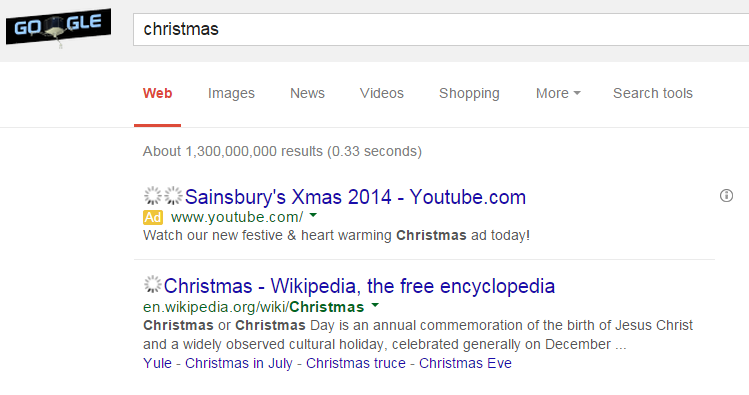The last article in the ‘Analyse A Real PPC Campaign’ series looked at Natoora which we found to have a few pros and cons to its landing page such as having slightly too much content on the landing page (too much for the web user to digest in seconds which may promote a higher exit/bounce rate). In this article, with Christmas creeping up ever closer to us, I thought I would do a festive analysis of a pay per click advertising on the first and only advert that showed: Sainsbury’s.
To view Sainsbury’s advert, I had to type into Google search UK, ‘christmas’: It is slightly surprising that Sainsbury’s has bid for such a vague keyword. The general rule in PPC is to never have one word keywords since these are usually too broad and will adopt too high a CPC. Nevertheless, the competition for ‘christmas’ looks to be low which may work in the favour of Sainsbury’s. All they want to do is spread the awareness of their new Christmas advert and by bidding on ‘christmas’ will help them achieve this.
It is slightly surprising that Sainsbury’s has bid for such a vague keyword. The general rule in PPC is to never have one word keywords since these are usually too broad and will adopt too high a CPC. Nevertheless, the competition for ‘christmas’ looks to be low which may work in the favour of Sainsbury’s. All they want to do is spread the awareness of their new Christmas advert and by bidding on ‘christmas’ will help them achieve this.
Here are the main points I saw with Sainsbury’s PPC search advert:
- They decided to include a URL in their title. Usually, this is the URL of the landing page (which it is). However, they need to rely on the web user searching for Sainsbury’s Christmas advert if they go to YouTube.com direct and if you are like me on YouTube, you can get sidetracked seriously easy!
- They have a call to action as the description which will be effective at enticing the web user into a click.
- The advert is very simple and does not have a lot of content. The main reason for this is to not give anything away about the advert before the web user watches it. Therefore, the only way they can gain any more information about the video advert is by clicking on the search advert. Sometimes presenting too little information in PPC can work to the campaign’s advantage.
After clicking on the above advert, I came to the following landing page: As you might be able to tell, the landing page is the YouTube page which has the Sainsbury’s Xmas advert on it. For this reason, it is clear the that the main conversion is to get the web user to watch the video with maybe a secondary conversion being to get the web user to subscribe to Sainsbury’s YouTube channel. For this reason, I think it is safe to say that this page does not need much improving. Google, who own YouTube, have optimised the layout of YouTube in a way to promote people to watch videos.
As you might be able to tell, the landing page is the YouTube page which has the Sainsbury’s Xmas advert on it. For this reason, it is clear the that the main conversion is to get the web user to watch the video with maybe a secondary conversion being to get the web user to subscribe to Sainsbury’s YouTube channel. For this reason, I think it is safe to say that this page does not need much improving. Google, who own YouTube, have optimised the layout of YouTube in a way to promote people to watch videos.
The only downside about using YouTube as a landing page is the fact that the web user may get sidetracked quite easily with other videos. However, if they are interested enough to click onto Sainsbury’s advert to watch the video, they are sure to spare a minute or so to watch the advert.




You must be logged in to post a commentLogin